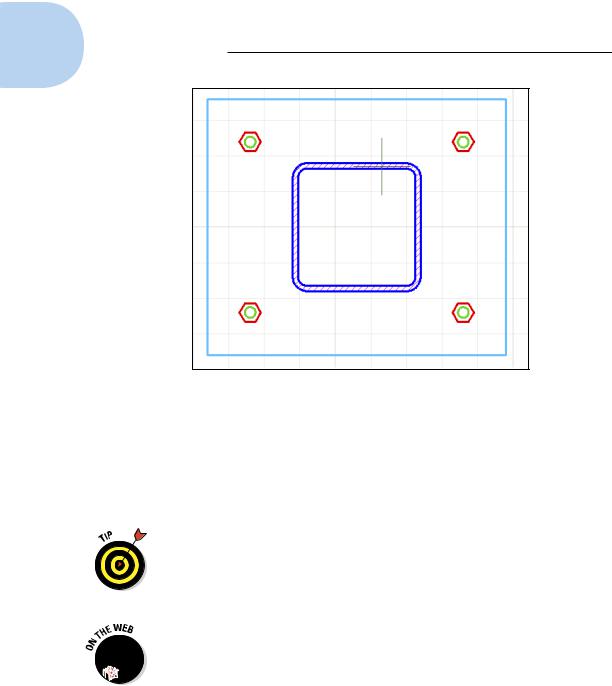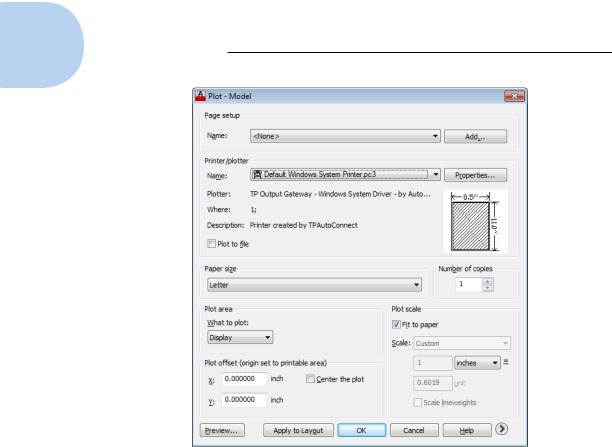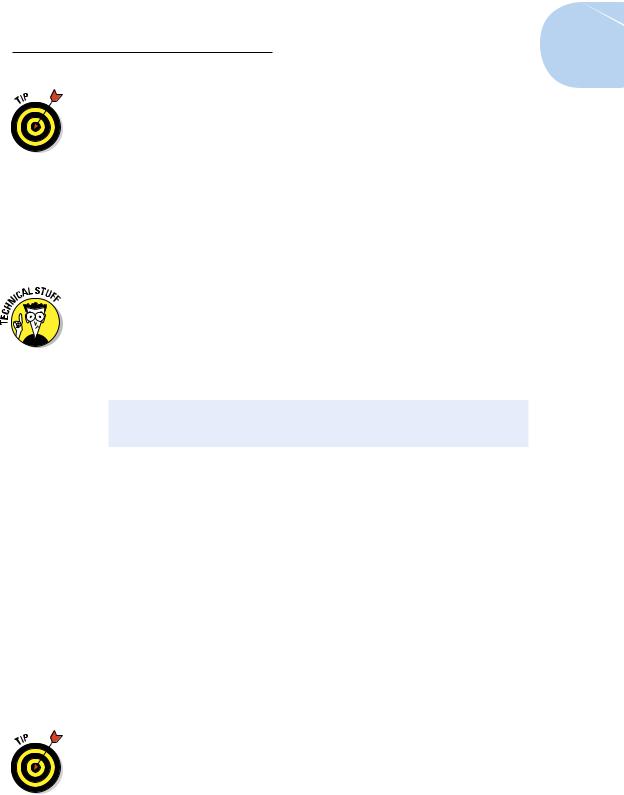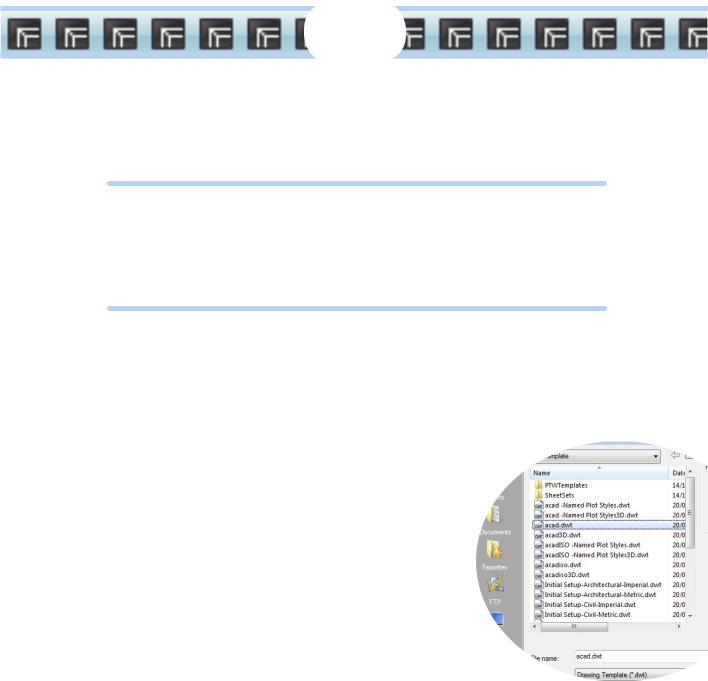
- •About the Authors
- •Dedication
- •Authors’ Acknowledgments
- •Table of Contents
- •Introduction
- •What’s Not (And What Is) in This Book
- •Mac attack!
- •Who Do We Think You Are?
- •How This Book Is Organized
- •Part I: AutoCAD 101
- •Part II: Let There Be Lines
- •Part III: If Drawings Could Talk
- •Part IV: Advancing with AutoCAD
- •Part V: On a 3D Spree
- •Part VI: The Part of Tens
- •But wait . . . there’s more!
- •Icons Used in This Book
- •A Few Conventions — Just in Case
- •Commanding from the keyboard
- •Tying things up with the Ribbon
- •Where to Go from Here
- •Why AutoCAD?
- •The Importance of Being DWG
- •Seeing the LT
- •Checking System Requirements
- •Suddenly, It’s 2013!
- •AutoCAD Does Windows (And Office)
- •And They’re Off: AutoCAD’s Opening Screens
- •Running with Ribbons
- •Getting with the Program
- •Looking for Mr. Status Bar
- •Let your fingers do the talking: The command window
- •The key(board) to AutoCAD success
- •Keeping tabs on palettes
- •Down the main stretch: The drawing area
- •Fun with F1
- •A Simple Setup
- •Drawing a (Base) Plate
- •Drawing rectangles on the right layers
- •Circling your plate
- •Nuts to you
- •Getting a Closer Look with Zoom and Pan
- •Modifying to Make It Merrier
- •Hip-hip-array!
- •Stretching out
- •Crossing your hatches
- •Following the Plot
- •A Setup Roadmap
- •Choosing your units
- •Weighing up your scales
- •Thinking annotatively
- •Thinking about paper
- •Defending your border
- •A Template for Success
- •Making the Most of Model Space
- •Setting your units
- •Making the drawing area snap-py (and grid-dy)
- •Setting linetype and dimension scales
- •Entering drawing properties
- •Making Templates Your Own
- •Setting Up a Layout in Paper Space
- •Will that be tabs or buttons?
- •View layouts Quick(View)ly
- •Creating a layout
- •Copying and changing layouts
- •Lost in paper space
- •Spaced out
- •A view(port) for drawing in
- •About Paper Space Layouts and Plotting
- •Managing Your Properties
- •Layer one on me!
- •Accumulating properties
- •Creating new layers
- •Manipulating layers
- •Using Named Objects
- •Using AutoCAD DesignCenter
- •Copying layers between drawings
- •Controlling Your Precision
- •Keyboard capers: Coordinate input
- •Understanding AutoCAD’s coordinate systems
- •Grab an object and make it snappy
- •Other Practical Precision Procedures
- •Introducing the AutoCAD Drawing Commands
- •The Straight and Narrow: Lines, Polylines, and Polygons
- •Toeing the line
- •Connecting the lines with polyline
- •Squaring off with rectangles
- •Choosing your sides with polygon
- •(Throwing) Curves
- •Going full circle
- •Arc-y-ology
- •Solar ellipses
- •Splines: The sketchy, sinuous curves
- •Donuts: The circles with a difference
- •Revision clouds on the horizon
- •Scoring Points
- •Commanding and Selecting
- •Command-first editing
- •Selection-first editing
- •Direct object manipulation
- •Choosing an editing style
- •Grab It
- •One-by-one selection
- •Selection boxes left and right
- •Perfecting Selecting
- •AutoCAD Groupies
- •Object Selection: Now You See It . . .
- •Get a Grip
- •About grips
- •A gripping example
- •Move it!
- •Copy, or a kinder, gentler Move
- •A warm-up stretch
- •Your AutoCAD Toolkit
- •The Big Three: Move, Copy, and Stretch
- •Base points and displacements
- •Move
- •Copy
- •Copy between drawings
- •Stretch
- •More Manipulations
- •Mirror
- •Rotate
- •Scale
- •Array
- •Offset
- •Slicing, Dicing, and Splicing
- •Trim and Extend
- •Break
- •Fillet and Chamfer and Blend
- •Join
- •When Editing Goes Bad
- •Zoom and Pan with Glass and Hand
- •The wheel deal
- •Navigating your drawing
- •Controlling your cube
- •Time to zoom
- •A View by Any Other Name . . .
- •Looking Around in Layout Land
- •Degenerating and Regenerating
- •Getting Ready to Write
- •Simply stylish text
- •Taking your text to new heights
- •One line or two?
- •Your text will be justified
- •Using the Same Old Line
- •Turning On Your Annotative Objects
- •Saying More in Multiline Text
- •Making it with Mtext
- •It slices; it dices . . .
- •Doing a number on your Mtext lists
- •Line up in columns — now!
- •Modifying Mtext
- •Gather Round the Tables
- •Tables have style, too
- •Creating and editing tables
- •Take Me to Your Leader
- •Electing a leader
- •Multi options for multileaders
- •How Do You Measure Up?
- •A Field Guide to Dimensions
- •The lazy drafter jumps over to the quick dimension commands
- •Dimension associativity
- •Where, oh where, do my dimensions go?
- •The Latest Styles in Dimensioning
- •Creating and managing dimension styles
- •Let’s get stylish!
- •Adjusting style settings
- •Size Matters
- •Details at other scales
- •Editing Dimensions
- •Editing dimension geometry
- •Editing dimension text
- •Controlling and editing dimension associativity
- •Batten Down the Hatches!
- •Don’t Count Your Hatches. . .
- •Size Matters!
- •We can do this the hard way. . .
- •. . . or we can do this the easy way
- •Annotative versus non-annotative
- •Pushing the Boundary (Of) Hatch
- •Your hatching has no style!
- •Hatch from scratch
- •Editing Hatch Objects
- •You Say Printing, We Say Plotting
- •The Plot Quickens
- •Plotting success in 16 steps
- •Get with the system
- •Configure it out
- •Preview one, two
- •Instead of fit, scale it
- •Plotting the Layout of the Land
- •Plotting Lineweights and Colors
- •Plotting with style
- •Plotting through thick and thin
- •Plotting in color
- •It’s a (Page) Setup!
- •Continuing the Plot Dialog
- •The Plot Sickens
- •Rocking with Blocks
- •Creating Block Definitions
- •Inserting Blocks
- •Attributes: Fill-in-the-Blank Blocks
- •Creating attribute definitions
- •Defining blocks that contain attribute definitions
- •Inserting blocks that contain attribute definitions
- •Edit attribute values
- •Extracting data
- •Exploding Blocks
- •Purging Unused Block Definitions
- •Arraying Associatively
- •Comparing the old and new ARRAY commands
- •Hip, hip, array!
- •Associatively editing
- •Going External
- •Becoming attached to your xrefs
- •Layer-palooza
- •Creating and editing an external reference file
- •Forging an xref path
- •Managing xrefs
- •Blocks, Xrefs, and Drawing Organization
- •Mastering the Raster
- •Attaching a raster image
- •Maintaining your image
- •Theme and Variations: Dynamic Blocks
- •Lights! Parameters!! Actions!!!
- •Manipulating dynamic blocks
- •Maintaining Design Intent
- •Defining terms
- •Forget about drawing with precision!
- •Constrain yourself
- •Understanding Geometric Constraints
- •Applying a little more constraint
- •AutoConstrain yourself!
- •Understanding Dimensional Constraints
- •Practice a little constraint
- •Making your drawing even smarter
- •Using the Parameters Manager
- •Dimensions or constraints — have it both ways!
- •The Internet and AutoCAD: An Overview
- •You send me
- •Send it with eTransmit
- •Rapid eTransmit
- •Bad reception?
- •Help from the Reference Manager
- •Design Web Format — Not Just for the Web
- •All about DWF and DWFx
- •Autodesk Design Review 2013
- •The Drawing Protection Racket
- •Autodesk Weather Forecast: Increasing Cloud
- •Working Solidly in the Cloud
- •Free AutoCAD!
- •Going once, going twice, going 123D
- •Your head planted firmly in the cloud
- •The pros
- •The cons
- •Cloudy with a shower of DWGs
- •AutoCAD 2013 cloud connectivity
- •Tomorrow’s Forecast
- •Understanding 3D Digital Models
- •Tools of the Trade
- •Warp speed ahead
- •Entering the third dimension
- •Untying the Ribbon and opening some palettes
- •Modeling from Above
- •Using 3D coordinate input
- •Using point filters
- •Object snaps and object snap tracking
- •Changing Planes
- •Displaying the UCS icon
- •Adjusting the UCS
- •Navigating the 3D Waters
- •Orbit à go-go
- •Taking a spin around the cube
- •Grabbing the SteeringWheels
- •Visualizing 3D Objects
- •Getting Your 3D Bearings
- •Creating a better 3D template
- •Seeing the world from new viewpoints
- •From Drawing to Modeling in 3D
- •Drawing basic 3D objects
- •Gaining a solid foundation
- •Drawing solid primitives
- •Adding the Third Dimension to 2D Objects
- •Creating 3D objects from 2D drawings
- •Modifying 3D Objects
- •Selecting subobjects
- •Working with gizmos
- •More 3D variants of 2D commands
- •Editing solids
- •Get the 2D Out of Here!
- •A different point of view
- •But wait! There’s more!
- •But wait! There’s less!
- •Do You See What I See?
- •Visualizing the Digital World
- •Adding Lighting
- •Default lighting
- •User-defined lights
- •Sunlight
- •Creating and Applying Materials
- •Defining a Background
- •Rendering a 3D Model
- •Autodesk Feedback Community
- •Autodesk Discussion Groups
- •Autodesk’s Own Bloggers
- •Autodesk University
- •The Autodesk Channel on YouTube
- •The World Wide (CAD) Web
- •Your Local ATC
- •Your Local User Group
- •AUGI
- •Books
- •Price
- •3D Abilities
- •Customization Options
- •Network Licensing
- •Express Tools
- •Parametrics
- •Standards Checking
- •Data Extraction
- •MLINE versus DLINE
- •Profiles
- •Reference Manager
- •And The Good News Is . . .
- •APERTURE
- •DIMASSOC
- •MENUBAR
- •MIRRTEXT
- •OSNAPZ
- •PICKBOX
- •REMEMBERFOLDERS
- •ROLLOVERTIPS
- •TOOLTIPS
- •VISRETAIN
- •And the Bonus Round
- •Index

80 Part I: AutoCAD 101
Figure 3-14: Your column is hatched.
8.Click the tiny arrow below the Zoom button on the Navigation bar and choose Zoom All from the menu.
AutoCAD zooms out so that the entire area defined by the limits is visible.
9.Press Ctrl+S to save the drawing.
After some drawing and editing, you may wonder how you’re supposed to know when to turn off or on the various status bar modes (Snap, Grid, Ortho, Object Snap, and so on). You’ll start to get an instinctive sense of when each mode is useful and when it gets in the way. If one of the modes gets in the way — or you find you need a mode — you can click the buttons at any time during editing and drawing commands. In subsequent chapters of this book, we give you some more specific guidelines.
Drawing afd03e-i.dwg [afd03e-m.dwg] available in the afd03.zip download is the completed base plate. How does it compare with your version?
Following the Plot
Looking at drawings on a computer screen and exchanging them with others via e-mail or websites is all well and good, but sooner or later, someone — maybe you! — will want to see a printed version. Printing drawings — or plotting, as CAD geeks like to call it — is much more complicated than
www.it-ebooks.info

Chapter 3: A Lap around the CAD Track 81
printing a word-processing document or a spreadsheet. That’s because you have to worry about things such as drawing scale, lineweights, title blocks, and weird paper sizes. We go deeper into plotting in Chapter 16, but this section gives you an abbreviated procedure that can help you generate a recognizable printed drawing.
The following steps show you how to plot the model space portion of the drawing. As Chapter 5 describes, AutoCAD includes a sophisticated feature — paper space layouts — for creating arrangements of your drawing that you plot.
These arrangements usually include a title block. Because we promised you a gentle tour of AutoCAD drafting functions, we save the discussion of paper space layout and title blocks for a bit later. When you’re ready for the whole plotting enchilada, turn to Chapter 5 for information about how to set up paper space layouts; see Chapter 16 for full plotting instructions.
Follow these steps to plot a drawing:
1.Click the Plot button on the Quick Access Toolbar.
The Quick Access Toolbar is at the left end of the program’s title bar, just to the right of the Application button. The Plot icon looks like an ordinary desktop printer.
AutoCAD opens the Plot-Model dialog box, with the title bar showing what you’re plotting (model space, in this case).
2.Click the More Options button (in the bottom-right corner of the dialog box, next to the Help button).
The Plot dialog box reveals additional settings, as shown in Figure 3-15.
3.In the Printer/Plotter area, select a printer from the Name dropdown list.
If in doubt, the Default Windows System Printer usually works.
4.In the Paper Size area, use the drop-down list to select a paper size that’s loaded in your printer or plotter.
Anything Letter size (81⁄2 x 11 inches) [A4 (210 x 297mm)] or larger works for this example.
5.In the Plot Area, select Limits from the drop-down list.
This is the entire drawing area, which you specified when you set up the drawing in the section “A Simple Setup,” earlier in this chapter.
6.In the Plot Offset area, select the Center the Plot check box.
Alternatively, you can specify offsets of 0 or other amounts in order to position the plot at a specific location on the paper.
www.it-ebooks.info

82 Part I: AutoCAD 101
Figure 3-15: The Plot dialog box with the More Options area visible.
7.In the Plot Scale area, deselect the Fit to Paper check box and choose 1:10 from the Scale drop-down list.
1:10 is the scale used to set up the drawing (which we explain in the section “A Simple Setup,” earlier in this chapter). No prizes for guessing the metric equivalent of 1:10!
8.In the Plot Style Table (Pen Assignments) area, click the drop-down list and choose monochrome.ctb.
The monochrome.ctb plot style table ensures that all your lines appear solid black, rather than as different colors or weird shades of gray. See Chapter 16 for information about plot style tables and monochrome and color plotting.
9.Click Yes when a question dialog box appears, asking Assign This Plot Style Table to All Layouts?
You can leave the remaining settings at their default values (refer to Figure 3-15).
www.it-ebooks.info

Chapter 3: A Lap around the CAD Track 83
Some printers let you print closer to the edges of the sheet than do others. To find out the actual printable area of your own printer, move the mouse pointer to the postage-stamp-size partial preview in the middle of the Plot dialog box and pause. A tooltip appears, listing the Paper Size and Printable Area for the printer and the paper size that you selected.
10. Click the Preview button.
If the plot scale you entered in the Plot dialog box is out of sync with the drawing’s annotation scale, a Plot Scale Confirm dialog box appears, advising you that the annotation scale isn’t equal to the plot scale. This drawing doesn’t contain any text or dimensions, and we didn’t bother making the hatch annotative, so it’s fine to click Continue and generate the plot.
Annotative scaling controls the printed size of text, dimensions, hatching, and other types of annotation objects at plot time — as long as the drawing’s annotation scale matches the plot scale. We explain annotative objects in Chapter 13.
The Plot dialog box disappears temporarily, and AutoCAD shows how the plot will look on paper. In addition, AutoCAD prompts you on the status bar as follows:
Press pick button and drag vertically to zoom, ESC or ENTER to exit, or right-click to display shortcut menu.
11.Right-click in the preview area and choose Exit.
12.If the preview doesn’t look right, adjust the settings in the Plot dialog box and look at the preview again until it looks right.
13.Click OK.
The Plot Scale Confirm dialog box pops up again. You may be tempted to click Always Continue Under These Conditions, but we recommend against that until you’ve gained a little familiarity with annotative objects.
The Plot dialog box closes. AutoCAD generates the plot and sends it to the printer. After generating the plot, AutoCAD displays a Plot and Publish Job Complete balloon notification from the right end of the status bar. (A Click to View Plot and Publish Details link displays more information about the plot job.)
14.Click the X (Close) button in the Plot and Publish Job Complete balloon notification.
The balloon notification disappears.
If you’re not happy with the lineweights of the lines on your plot at this point, fear not. You can use the lineweights feature (Chapter 6) or plot styles (Chapter 16) to control plotted lineweights.
15. Press Ctrl+S to save the drawing.
www.it-ebooks.info

84 Part I: AutoCAD 101
Congratulations! You successfully executed your first plot in AutoCAD. Chapter 16 tells you more — much more — about AutoCAD’s highly flexible (but occasionally perplexing) plotting system.
www.it-ebooks.info

4
Setup for Success
In This Chapter
Developing a setup strategy
Starting new drawings
Setting up model space
Creating and using drawing templates
Surprisingly, drawing setup is one of the trickier aspects of using AutoCAD. It’s an easy thing to do incompletely or incorrectly, and
AutoCAD 2013 doesn’t provide a simple, one-click tool to help you do all of it right. And yet, drawing setup is a crucial thing to get right. Setup steps that you omit or don’t do right may come back to bite you later. The good news is that if you do things properly, you need to do them only once.
The really good news is that AutoCAD is extremely versatile and flexible. As a general rule, the easier something is
to use, the less able you are to bend, fold, staple, and mutilate to get it to work in some perverse way that’s unique to you and your needs.
Sloppy setup really becomes apparent when you try to plot (print) your drawing. Things that seemed more or less okay as you zoomed around on the screen are suddenly the wrong size or scale on paper. And nothing brands someone as a naïve AutoCAD wannabe as quickly as the inability to plot
a drawing at the right size and scale. Chapter 5 covers plotting setup procedures, but the information in this chapter is a necessary prerequisite to successful plotting and sheet setup. If you don’t get this stuff right, there’s a good chance you’ll find that . . . the plot sickens.
This chapter describes the decisions you need to make before you set up a new drawing, shows the steps for doing a complete and correct setup, and demonstrates how to save setup settings for reuse.
www.it-ebooks.info
